Elevator pitch
Gender wage gaps and women’s underrepresentation in leadership positions exist at remarkably similar magnitudes across countries at all levels of income per capita. Women’s educational attainment and labor market participation have improved, but this has been insufficient to close the gaps. A combination of economic forces, cultural and social norms, discrimination, and unequal legal rights appear to be contributing to gender inequality. A range of policy options (such as quotas) have been implemented in some countries; some have been successful, whereas for others the effects are still unclear.
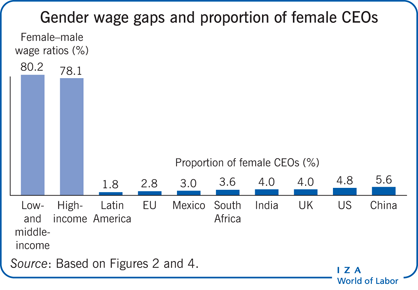
Key findings
Pros
Women’s educational attainment and labor market participation have improved in middle-income and, to a lesser extent, in low-income countries.
Women’s presence in professional, technical, and managerial roles and leadership positions in politics has increased in recent decades.
Increased female representation in government and corporate leadership can benefit women at lower ranks and help change perceptions about the role of women in society.
In recent years, several women have become CEOs of important companies, providing role models for other women.
Cons
Male–female wage differentials are large and persistent and do not automatically shrink with economic development.
Despite some gains, women remain severely underrepresented in top leadership positions in institutions and firms.
Gender gaps in wages and representation in managerial positions likely reflect an inefficient allocation of talent, with negative consequences for growth.
In many low- and middle-income countries, legal provisions exist that restrict women’s freedoms and opportunities.
Author's main message
Policy interventions aimed at increasing women’s human capital are essential; however, they cannot be expected to automatically close the gender gaps in labor force participation, wages, and political and corporate leadership that exist in countries at different levels of income per capita. In some contexts, affirmative action and gender quotas have had positive effects and also created role models. Eliminating legal discrimination against women, and promoting policies to counteract discrimination and cultural and social norms that, in many countries, have traditionally assigned women subordinate roles should be critical policy goals.
Motivation
Gender disparities exist in virtually all countries around the world, with women being disadvantaged in many areas such as health, education, and labor market opportunities. Male–female gaps are especially large in developing countries [1]. This phenomenon raises issues of social justice and human rights, and might also lead to substantial economic costs to society if it results in an inefficient allocation of talent and distorts the incentives to invest in human capital. It is therefore worthwhile to identify and quantify the specific gender gaps that exist with respect to wages and leadership positions within institutions and organizations. Comparing these gaps as they exist in countries at all levels of income can provide insights into their causes and consequences, and can help understand the link between the two phenomena. It is also useful to examine how policy has so far been used to address these gaps, and how lessons from these experiences can be applied towards future policy recommendations.
Discussion of pros and cons
Gender gaps have narrowed in high- and middle-income countries, but remain large in low-income countries
In the past decades, several indicators of women’s involvement in the economy have improved around the world. These advances have occurred both in absolute terms and relative to men. The accumulation of human capital through formal education, for example, represents an essential prerequisite for productive participation of individuals in the labor market. Figure 1 shows that the ratio of women to men enrolled in primary and secondary education increased from 0.70 in the period 1990–1995 to 0.89 in 2010–2014 in low-income countries, and from 0.89 to 0.97 in lower-middle-income countries. Similarly, increases are observed in the share of women enrolled in tertiary education (universities and other post-secondary institutions). The ratio of women to men enrolled at tertiary level in public and private schools went from 0.97 in 2000 to 1.13 in 2012 in lower-middle-income countries and from 1.24 to 1.32 in upper-middle-income countries (this indicates that more women than men are now enrolled in tertiary education in middle- and high-income countries). In low-income countries, the ratio has increased from 0.5 to 0.6, suggesting a modest improvement, though clearly still lagging behind wealthier countries.
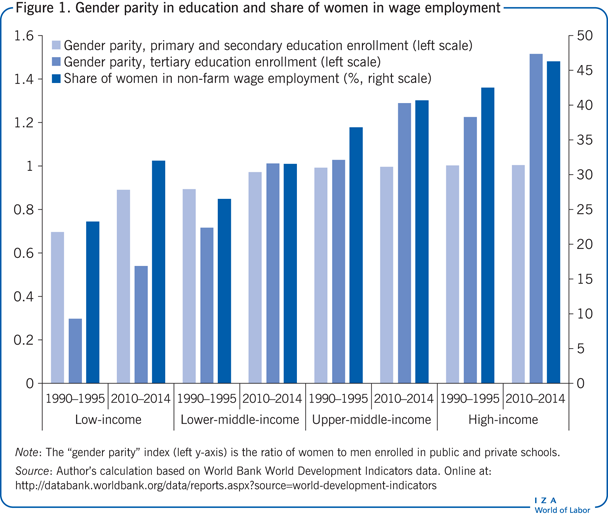
Figure 1 also reports the share of women in non-farm wage employment, an indicator of the contribution of women in the sectors of the economy typically characterized by higher productivity. On this front, progress has been made in countries at all levels of economic development. In the period 2010–2014, women represented 46% of total non-farm wage employment in high-income countries, up from 42% in 1990–1995. In low-income countries, the increase over the same period has been substantial, with women’s share of non-farm employment growing from 23% to 32%; a similar increase, from 26.5% to 31.5% is observed in lower-middle-income countries. However, the levels of female participation in paid non-farm employment are still substantially lower in middle- and low-income countries compared to high-income countries.
Large gender wage gaps exist in countries at all levels of GDP per capita
What about gender wage differentials? Given that women in high-income countries enjoy similar (and sometimes higher) levels of education than men, while women in lower-income countries are still at an educational disadvantage, one would expect male–female wage gaps to be systematically smaller in higher-income countries. Figure 2 plots female–male earnings ratios against GDP per capita. Three main messages emerge from this figure. First, women’s earnings are lower than men’s in virtually all countries; on average, the female–male earnings ratio is 79.8, indicating that women earn 20% less than men. Second, there is wide variation in the female–male earnings ratio around the world, ranging from below 60 to slightly above 100. The third and perhaps most striking feature of the data is that there appears to be essentially no relationship between the level of GDP per capita and the gender wage gap; in particular, earnings disparities between women and men are not narrower in richer countries. More specifically, women’s earnings are 80% of men’s in countries with GDP per capita below $10,000, 82% in countries with GDP per capita between $10,000 and $30,000, and 76% in countries with GDP per capita above $30,000. Thus, although women in many countries have reached parity with men in terms of formal educational attainment and participation in wage employment (Figure 1), there appears to be no correlation between the gender wage gap and per capita GDP (Figure 2).
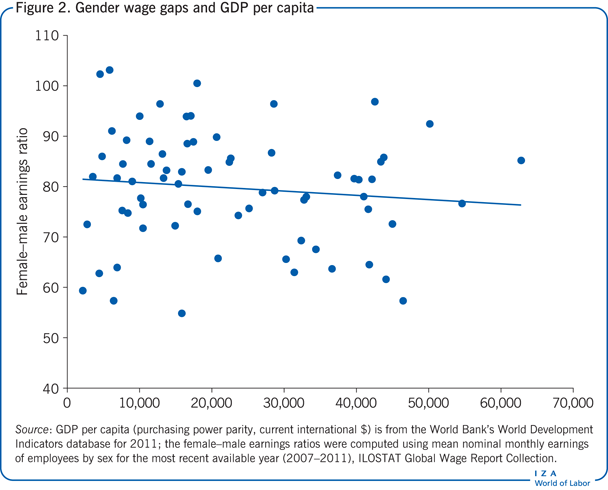
Female leaders are underrepresented at all levels of GDP
As shown in Figure 1, women’s participation in non-farm wage employment has increased substantially in the past decades in low-, middle-, and high-income countries; women are also bridging the education gap, as indicated by increased tertiary education enrollment rates. Yet, in spite of increased human capital and labor market participation, women remain underrepresented in leadership positions in institutions and organizations. As Figure 3 illustrates, women only hold around 20% of parliamentary seats worldwide; the percentage is only slightly higher in high-income countries (23.8%) than in low-income countries (20.3%). This important measure of women’s participation in political life has shown substantial increases over time. In particular, in low-income countries, women’s share of parliamentary seats went from about 10% in 1990 to 20% in 2015. Despite these improvements, women’s share of parliamentary seats remains below their share in the labor force, not to mention the population at large. The underrepresentation of women in positions of leadership is even more dramatic at the very top of political institutions. As of October 2015, a woman was president or prime minister in only 16 of the countries included in the World Bank’s World Development Indicators database. As reported in Figure 3, the proportion of female prime ministers or heads of state was 12.5% in high-income countries, around 5% in middle-income countries, and about 3% in low-income countries in 2015.
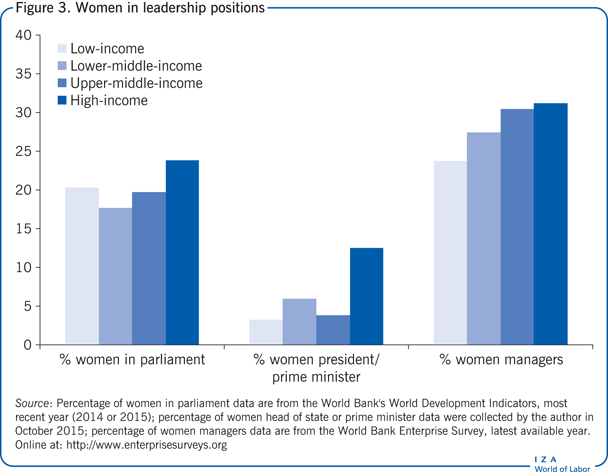
A similar picture emerges when looking at women’s representation in firms. According to data from the World Bank Enterprise Surveys, based on surveys of more than 100,000 private firms in 126 countries, about 29% of top managers were women on average in the most recent available year. Figure 3 reveals that the proportion of female top managers is highest in high-income countries and lowest in low-income countries, but the difference is only seven percentage points (31% vs 24%).
Looking at the very top of organizations, a similar picture emerges. A recent publication by the International Labour Organization (ILO) reports data on the proportion of female CEOs in publicly listed companies in several countries. The proportions are remarkably small, with women being severely underrepresented among the largest publicly traded firms in all countries. Data for a group of selected countries and regions are presented in Figure 4. Women represent 4.8% of CEOs in the US Fortune 500 companies, 5.6% in China’s publicly listed companies, 1.8% in Latin 500 companies, 2.8% in publicly traded companies in the EU, 3% among the Mexico Expansion 300 companies, and 4% of CEOs among India’s Mumbai Stock Exchange 100 companies. The ILO publication includes more detailed analyses of a group of countries, reporting that in spite of significant improvements in women’s presence in professional, technical, and managerial roles, only a small fraction of CEO and other top executive positions are held by women. Thus, when looking at both political institutions and firms, one finds that “glass ceilings” do seem to be in place, which prevent women from advancing to the highest ranks.
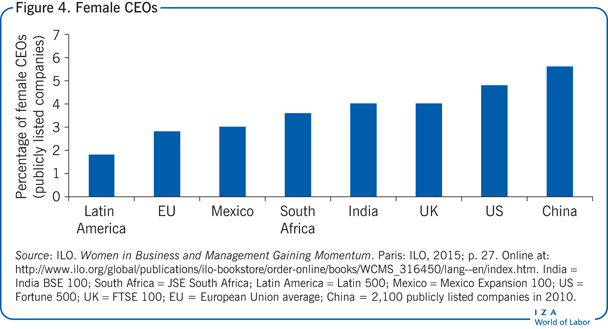
Explaining gender wage gaps
Women’s disadvantage in developing countries is not limited to the labor market. Gender disparities exist in health and education, in basic freedoms and autonomy, and in the distribution of bargaining power within the household [1]. Some of these gender gaps do decline with economic development; for example, as in the above case regarding educational attainment and paid labor force participation. However, the fact that earnings gaps and the underrepresentation of women in top leadership positions are remarkably similar across countries at very different levels of GDP per capita indicates that economic development does not automatically close all gender gaps, and that other causes and mechanisms must also be at play.
A large literature in labor economics is devoted to “explaining” the gender wage gap. Most of the literature focuses on high-income countries (notably the US). This is primarily due to the greater availability of high-quality data in higher-income countries. Moreover, the nature of work, particularly women’s work, in poor countries is often very different than in richer countries, which means that “standard” comparisons of wages and career progression may not be applicable in those contexts. Different patterns of selection by gender into the paid labor force complicate the picture even further.
A comprehensive gender wage gap decomposition exercise was performed with data from 64 countries around the world, including several middle- and low-income countries [2]. This exercise was meant to determine how much of the gender gap in hourly earnings is accounted for by individual characteristics and job characteristics and it can shed light on the causes of gender gaps, and thus potentially inform policy. For example, if differential educational attainment explains much of the gap, then interventions aimed at increasing pre-labor market human capital accumulation by women should be pursued more aggressively; if, on the other hand, industry or occupation are responsible for a large portion of the gap, then attention should also be devoted to better understanding the causes of occupational segregation by gender. It is important to examine these issues on a country-by-country basis, because gender gaps could well have different causes in different places, and there could also be important differences between groups within a country. There are several results of interest in this study. In Africa, the Middle East, and South Asia, a large fraction of the gender gap is explained by demographic characteristics. On the other hand, in Western Europe, Eastern and Central Asia, East Asian and Pacific countries, and in Latin America and the Caribbean, female workers, on average, possess characteristics (e.g. education) that, in principle, should make them earn higher wages than men in the labor market. In particular, in Eastern and Central Asia, the Middle East, North Africa, and East Asian and Pacific countries, higher educational achievements by women do not appear to be rewarded in the labor market. Job-related characteristics such as occupation and industry are also found to play a role, although a substantial portion of the gender gap remains “unexplained.”
Although more research is needed, the findings reported above indicate that improvements in educational attainment may not automatically translate into reduced gender earnings gaps; similarly, reducing occupational segregation is helpful, but also is not likely to entirely close gender disparities in earnings, suggesting that other factors, possibly including discrimination, gender roles and the division of labor within the household, as well as psychological traits and non-cognitive skills may be at play.
Causes and consequences of women’s underrepresentation in leadership roles
Although female underrepresentation in leadership positions is a widespread phenomenon, the causes of this phenomenon might be different in different contexts. Studying these causes with respect to an organization’s top level is difficult due to the complex process of selection and allocation of executives to firms. Some recent studies have taken advantage of variation prompted by sudden policy changes (e.g. the introduction of gender quotas) to estimate the effects of female leadership on a range of outcomes, whereas other studies report the results of randomized field experiments. One study based on data from 16,000 firms in 73 developing countries finds that countries with higher female–male ratios in primary, secondary, and tertiary education enrollment rates also have higher proportions of female top managers [3]. Though female underrepresentation remains substantial, these findings suggest that improving women’s educational access and attainment in developing countries can at least help create the conditions for women to achieve leadership roles in firms.
Another recent study analyzed a large data set of publicly traded companies in Latin America and the Caribbean [4]. This study finds that companies with more female members on the board of directors are significantly more likely to have one female among the firm’s executives, and that when women make up at least 30% of executives, there is a positive association with firm performance. The latter result is consistent with findings from a study using matched employer–employee data from Italy, which found that the impact of female leadership on firm performance (sales, value added, and total factor productivity) increases with the share of female workers in the firm [5]. Moreover, the Italian study finds that female CEOs are associated with higher wages for women at the top of the female wage distribution but not at the bottom, which the authors interpret as being consistent with statistical discrimination. Research using data from more than 30,000 firms in 74 developing countries documents that when a firm’s dominant shareholder is a woman, there is a considerably higher probability that the company’s CEO is also a woman [6], and a study using rich matched employer–employee data from Norway finds that greater female representation at higher ranks of the corporate hierarchy narrows the gender gap in promotion rates at lower ranks [7]. These results suggest that, at least in part, the effect of female leaders works through their interaction with the female workforce, and that the underrepresentation of women at the top of companies’ hierarchies might be generating substantial efficiency costs due to the misallocation of female talent. The results also indicate that “women help women” (particularly talented women), and that policies that increase female representation in corporate leadership might also have positive effects for women at lower ranks.
The role of psychology and socio-cultural factors
Recently, in addition to human capital and discrimination, a range of psychological factors have been proposed as explanations for gender gaps in the labor market. For example, evidence suggests that women may be more risk-averse, and less willing to negotiate and compete than men, which could explain both women’s lower wages and their underrepresentation in top positions in organizations. Social and cultural factors also appear to play a role. In a study of the effect of attitudes toward gender roles on labor market outcomes in a sample of OECD countries, a strong negative correlation is found between anti-egalitarian views (e.g. the perception that women’s role in society is that of homemakers and the role of men is to be breadwinners) and female employment rates and gender earnings gaps [8]. There is also evidence that the evolution of attitudes concerning gender roles is correlated with the evolution of the gender gap in labor force participation. This indicates that changes in social norms and perceptions can have real effects on behaviors and outcomes, although the effects are more likely to manifest themselves over medium–long periods of time. Psychological and cultural factors can potentially interact with each other. For example, women might avoid competitive settings or be reluctant to negotiate to comply with prevailing social norms or stereotypes that assign them a certain role.
Unequal rights and access to information
In many countries, women are not afforded the same opportunities as men. This is especially the case in developing countries. A recent World Bank report describes several government policies that limit women’s participation in the labor market, particularly their ability to engage in entrepreneurial activities [9]. In 155 of the 173 economies covered, there is at least one legal barrier for women that does not exist for men. For example, in 18 countries, husbands are legally allowed to prevent their wives from working, and in some countries women are legally required to obtain their husband’s permission before they can register a business. Not surprisingly, the report finds that lower legal gender equality is associated with worse outcomes for women, including lower enrollment in secondary school, lower labor force participation, larger earnings differentials, and reduced propensity to start or run a business. Reforms granting women equal rights have been implemented in many countries, particularly in developing countries. However, enforcement is often weak [1], [9]. The lack of access to certain positions, occupations or industries creates informational barriers for women that can contribute to the perpetuation of disparities, even in the absence of legal restrictions. This concept is supported by evidence from Uganda, which indicates that lack of information about opportunities in male-dominated sectors explains gender differences in sector choice [10].
Policy options to increase female representation in leadership positions
In recent years, several countries have introduced quotas to increase women’s representation in legislative bodies and corporate boards. In addition to ensuring a gender composition that better reflects electoral bodies or companies’ workers, these policies’ goals include influencing the kinds of policies enacted by government bodies or companies, and changing attitudes toward gender roles in society. Most of these reforms are too new to be properly assessed, though some rigorous evaluations have been performed.
In India, one-third of village council head positions are reserved for women. The effects of this policy were evaluated by exploiting the policy’s random assignment of village councils where only women could be elected as council head [11]; the findings indicate that female leaders implemented policies that were more relevant to the needs of other women in their jurisdiction. Another study finds that the same policy had a “role model” effect, which changed young girls’ career aspirations (and their parents’), eliminated gender gaps in educational attainment, and reduced girls’ time spent on household chores [12]. Further evidence on the effects of similar policies comes from studies focusing on a group of European countries, which have introduced gender quotas in corporate boards. One example is Norway, which in 2006 mandated that 40% of seats on publicly traded companies with certain characteristics be reserved for women. This reform reduced the gender gap in earnings among board members but did not have a significant impact on overall gender wage gaps or female representation in top managerial positions in the firms affected [13]; also, no effects were found on young females’ enrollment in business education programs, or on their fertility and marital plans. However, the observed effects are short-term, and it is still too soon to estimate longer-term effects that the reform might eventually have.
Limitations and gaps
The empirical literature on the causes and effects of women’s underrepresentation in leadership positions in developing countries is scarce, as is the body of empirical work on gender wage gaps in developing countries. In particular, there is a paucity of work based on longitudinal data and matched employer–employee data. These data sets, now widely used in studies that focus on high-income countries, are better suited than cross-sectional data to derive causal relationships. Matched employer–employee data can be particularly useful to study discrimination in the workplace. Government-mandated gender quotas are useful from a scholarly point of view because they create quasi-exogenous variation, which helps with the identification of causal effects; however, many reforms were passed only recently, and therefore it is too soon to estimate their full potential effects.
Summary and policy advice
Substantial gender wage differentials exist in countries at very different levels of economic development, and women are greatly underrepresented in leadership positions in political institutions and firms. However, in many countries, women and men now participate equally in the labor force; and in the case of education, in many countries the gender gap has actually been reversed, with female enrollment often surpassing male enrollment. Despite these gains, the magnitude and persistence of wage and leadership gender gaps continues to pose some challenges to scholars and policymakers.
Research on the wage gap suggests that factors such as education, occupation, and industry explain only part of the differences, and that other factors are at play, including gender differences in psychological traits (e.g. risk aversion and attitudes toward negotiation and competition), socio-cultural norms and dynamics (e.g. norms that traditionally assign women and men different roles in the household and in society), and discrimination. There is no consensus about the relative importance of these factors, and in some areas the literature is still young and scarce.
Research on the causes and consequences of gender gaps in leadership positions in organizations has grown in recent years, although, similarly to research on wage gaps, most of it is based on data from high-income countries. Some of this research emphasizes the role of interactions between female leaders and other women in the firm through various channels, including communication, mentoring, and offering role models. In addition to raising issues of social justice, there are indications that these gender disparities are economically inefficient because they imply a sub-optimal allocation of female talent.
Some countries have introduced gender quotas in leadership positions in political institutions and firms. In India, evidence indicates that female leaders implemented policies that benefited other women, and also created role models that influenced young women’s education and career aspirations and decisions. Evidence from gender quotas in companies’ boards of directors is more mixed, however these policies were implemented in recent years, and some of the effects will probably take time to become visible.
Policy interventions aimed at reducing gender disparities in education and labor market participation are important. In low-income countries, women display enrollment rates considerably lower than males in primary, secondary, and tertiary education. Moreover, in many developing countries, women are held back by significant legal restrictions that limit their rights within the household, curbing their ability to participate in the labor market and society. Recent trends show improvement of women’s legal rights in many countries, but further policy action is needed.
Acknowledgments
The author thanks an anonymous referee and the IZA World of Labor editors for helpful suggestions on earlier drafts. The author would also like to thank David Evans, Fernanda Ruiz Nuñez, and Fabiano Schivardi for comments, and Luca Flabbi, Andrea Moro, and Fabiano Schivardi for many conversations and our joint research on some of the topics of this article.
Competing interests
The IZA World of Labor project is committed to the IZA Guiding Principles of Research Integrity. The author declares to have observed these principles.
© Mario Macis